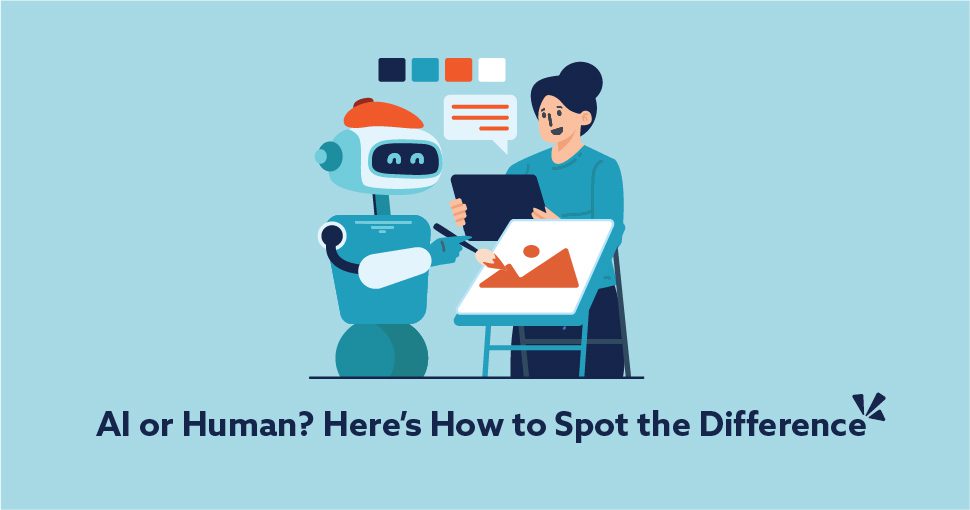AI or Human? Here’s How to Spot the Difference

AI-generated content is everywhere these days, from emails to entire blog posts (not this one, it’s a human from Pinnacle 😉). While it can be a powerful tool when used intentionally, it’s also pretty easy to sniff out when you’re paying attention. Here’s your quick-and-clear cheat sheet to help you spot when a robot might’ve been behind the keyboard.
Read Between the Lines
1. It’s a Little Too Polished
If something reads like it came straight out of a grammar workbook, it might’ve been AI-generated. Every sentence is perfectly structured. Every paragraph flows like clockwork. It sounds…fine. But maybe too fine.
2. Buzzword Overload
Watch out for buzzwords like “cutting-edge solutions” or “transformative results.” These sound nice but often say very little. AI loves padding content with corporate “fluff” instead of real, grounded language.
3. Stuck on Repeat
AI has a habit of looping. It may rephrase the same idea many different ways throughout a piece, all while pretending it’s saying something new. If you feel like you’re stuck in a content déjà vu trust that feeling. It’s probably AI.
4. Generic and Boring
AI leans into generic examples like, “Businesses looking to grow can achieve success through effective marketing strategies.” Yeah, okay? But which company? How? There’s usually no lived experience, just hypotheticals.
5. No Personality
Humans typically write with voice; they have their own writing style. Maybe it’s quirky, maybe it’s snarky, maybe it’s straightforward. AI tends to sound neutral, safe, and a little boring. If it reads like a textbook or press release, chances are it didn’t come from a real person.
6. Fake Facts & Empty Links
Be cautious of stats that seem a little too perfect. AI will sometimes generate data or citations that don’t actually exist. No source? No timestamp? Red flag.
7. Weird but “Correct” Wording
Just because something is grammatically sound doesn’t mean it sounds natural. AI often writes like it’s trying to impress a professor: “synergizing strategic priorities” is technically fine, but who talks like that?
Punctuation Tells, So Look for the Clues
Even the smallest punctuation choices can give AI-generated content away. More often than not, this is more noticeable than the words themselves.
8. Em Dashes (—)
- AI loves using them in place of parentheses and uses them with balanced, textbook symmetry:
“The campaign—targeted and strategic—delivered exceptional results.” - Real people? We get messier:
“We were so close—like, painfully close.” - If the dashes are overly neat, overly formal, or emotionally flat…it might be AI.
9. Ellipses (…)
- AI rarely uses them unless you ask.
- When humans use ellipses, it usually adds tone or hesitation:
“Well… that could’ve gone better.”
10. Semicolons (;)
- AI uses them correctly. Every. Single. Time.
- Humans? We tend to avoid them altogether or toss them in when unsure.
This human actually has a background in English and grammar and even she favors NOT using them. For those of you who don’t know, a semicolon is typically used on two complete sentences that are closely related (I put one in this blog post as an example 😊).
11. Commas (,)
- AI will never forget the Oxford comma. An Oxford comma is the comma that comes before the “and” in a list of three or more words “We need milk, butter, bread, and eggs from the store.”
- Real people? Inconsistent at best. We write more like we talk and sometimes that means bending comma rules. “We need milk, butter, bread and eggs from the store.”
Sorry, but I’m jumping in again. Depending on the English teacher you had, you might have learned to always use the Oxford comma (I know mine preferred it). So, depending on the writer, this “tell” might not actually be a giveaway.
12. Periods (.)
- AI content has evenly spaced, complete sentences.
- Human writing? We like fragments. Rhythm. Style.
“Not great. But it worked.”
13. Exclamation Points (!)
- AI: “This is a fantastic opportunity!”
- Humans tend to use emotion over formality. “We finally launched it!” or “YES!”
AI writing is neat. Polished. Structured. Human writing is messier in the best ways. It has rhythm, emotion, personality, and the occasional rogue semicolon. So, next time you’re reading a piece of content, and something feels just a little…robotic? Trust your gut.